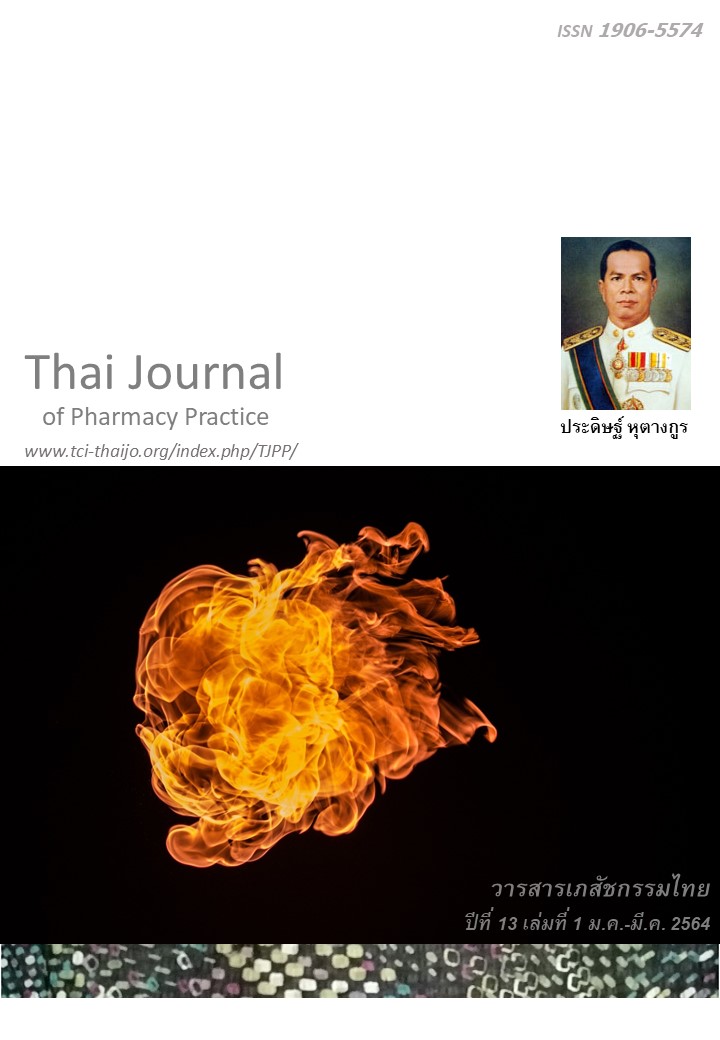ผลของการที่ผู้บริโภคใช้เกณฑ์การประเมินความน่าเชื่อถือของเว็บไซต์ ที่มีการโฆษณาผลิตภัณฑ์สุขภาพ: กรณีศึกษาผลิตภัณฑ์เสริมอาหาร
Main Article Content
บทคัดย่อ
วัตถุประสงค์: ประเมินผลของการที่ผู้บริโภคใช้เกณฑ์การประเมินความน่าเชื่อถือของเว็บไซต์ที่โฆษณาผลิตภัณฑ์เสริมอาหาร (credibility evaluation of websites with advertisings of diet supplementary: CEWADS) วิธีการ: การศึกษาแบ่งออกเป็น 3 ส่วน การศึกษาส่วนที่1 เป็นการสร้างเกณฑ์ CEWADS สำหรับผู้บริโภค โดยส่งเกณฑ์ฉบับร่างไปยังกลุ่มผู้เชี่ยวชาญทางด้านการคุ้มครองผู้บริโภคด้านยาและสุขภาพจำนวน 21 ท่านเพื่อประเมินด้วยเทคนิค Delphi จำนวน 3 รอบ การศึกษาส่วนที่ 2 ทดสอบความถูกต้องของเกณฑ์ CEWADS โดยผู้วิจัยใช้เกณฑ์ดังกล่าวประเมินความน่าเชื่อถือของเว็บไซต์ที่มีการโฆษณาผลิตภัณฑ์สุขภาพ 20 แห่ง และหาความสัมพันธ์ของคะแนนที่ได้กับคุณภาพของเว็บไซต์ที่ประเมินโดยผู้เชี่ยวชาญ 2 ท่านต่อเว็บไซต์ 1 แห่ง การศึกษาส่วนที่ 3 ประเมินผลการใช้เกณฑ์ CEWADS โดยผู้บริโภคเพื่อประเมินเว็บไซต์ที่มีความน่าเชื่อถือสูงและต่ำ (อย่างละ 1 เว็บไซต์) โดยเลือกตามคะแนนการประเมินโดยผู้เชี่ยวชาญในการศึกษาส่วนที่ 2 การทดสอบทำในประชาชนผู้บริโภคทั่วไปจำนวน 140 คนในอำเภอหาดใหญ่ จังหวัดสงขลา ผู้บริโภคถูกสุ่มแยกเป็นกลุ่มควบคุม (n= 70) และกลุ่มทดลอง(n= 70) โดยใช้การสุ่มแยกตัวอย่างแบบบล็อก กลุ่มควบคุมประเมินความน่าเชื่อถือของเว็บไซต์ตามความเห็นของตน กลุ่มทดลองศึกษา เกณฑ์ CEWADS ก่อนประเมินความน่าเชื่อถือของเว็บไซต์ ผลการวิจัย: เกณฑ์ CEWADS ที่ผ่านการพิจารณาของผู้ทรงคุณวุฒิในกระบวนการ Delphi มีจำนวน 7 ข้อ ผลการประเมินคุณภาพของเว็บไซต์โดยผู้เชี่ยวชาญมีความสัมพันธ์เชิงบวกกับผลการประเมินโดยผู้วิจัยตามเกณฑ์ CEWADS (r= 0.65) กลุ่มทดลองสามารถแยกแยะคุณภาพของเว็บไซต์ที่มีความน่าเชื่อถือสูงและต่ำได้ดีกว่ากลุ่มควบคุม (P<0.001) ในเว็บไซต์ที่มีความน่าเชื่อถือสูง กลุ่มทดลองให้คะแนนความน่าเชื่อถือ (3.91±0.10 จากคะแนนเต็ม 5) ซึ่งสูงกว่ากลุ่มควบคุม (3.24±0.10 จากคะแนนเต็ม 5) อย่างมีนัยสำคัญทางสถิติ ส่วนเว็บไซต์ที่มีความน่าเชื่อถือต่ำ กลุ่มทดลองประเมินเว็บไซต์ว่ามีความน่าเชื่อถือ (2.34± 0.09) น้อยกว่ากลุ่มควบคุม (3.44±0.09) อย่างมีนัยสำคัญทางสถิติ สรุป: การให้ผู้บริโภคทราบเกณฑ์การประเมินความน่าเชื่อถือของเว็บไซต์ช่วยเพิ่มความสามารถในการแยกแยะคุณภาพของข้อมูลที่แสดงบนเว็บไซต์ ดังนั้นจึงควรส่งเสริมเกณฑ์ที่มีลักษณะเดียวกับที่ใช้ในงานวิจัยนี้
Article Details
ผลการวิจัยและความคิดเห็นที่ปรากฏในบทความถือเป็นความคิดเห็นและอยู่ในความรับผิดชอบของผู้นิพนธ์ มิใช่ความเห็นหรือความรับผิดชอบของกองบรรณาธิการ หรือคณะเภสัชศาสตร์ มหาวิทยาลัยสงขลานครินทร์ ทั้งนี้ไม่รวมความผิดพลาดอันเกิดจากการพิมพ์ บทความที่ได้รับการเผยแพร่โดยวารสารเภสัชกรรมไทยถือเป็นสิทธิ์ของวารสารฯ
เอกสารอ้างอิง
Electronic Transactions Development Agency Ministry of Information and Communication Technology. Thailand Internet user profile 2016 [online]. 2016 [cited Sep 26, 2017]. Available from: www.etda.or.th/publishing-detail/thailand-internet-user-profile-2016-th.html.
Pew Research Center. Internet/Broadband fact sheet [online] 2017 [cited Oct 28, 2017]. Available from: www.pewinternet.org/fact-sheets/health-fact-sheet.
Health Intervention and Technology Assessment. Project proposals on the structure of consumer protection of health products in Thailand 2016 [online]. 2016 [cited Sep 29, 2017]. Available from: www.hitap.net/documents/166401.
Rathanapongjinda N. Survey of weight loss product advertising information and products that help to understand that weight loss, which is published on the internet [independent study]. Phitsanulok: Nare suan University; 2011.
Kanjamajittra C. Unrealistic health and uncontrolled Ads in Thai Health 2011: HIA mechanism for developing health policy for life and health. Nakhon Pathom: Institute for Population and Social Research, Mahidol University; 2011.
Sirisinsook Y, Thongyoung P, Poomkokrak O, Suwankeesawong W, Sripirom P, Katunyootha P. The management of illegal advertising drugs and health products via local radio, cable TV, satellite television and internet. Yawipak 2011; 3: 17–8.
Prachusilpa S, Oumtanee A, Satiman A. A study of dissemination of health information via internet Stud Health Technol Inform 2006; 122: 775.
Pokasung M. Health related website, Interactive health communication and content quality in medical and public health aspects [master thesis]. Bangkok: Chulalongkorn University; 2008.
Wathen CN, Burkell J. Believe it or not: Factors influencing credibility on the Web. Am Soc Inf Sci Technol 2002; 53: 133–44.
Henna K, Xie B. Health literacy in the eHealth era: A systematic review of the literature. Patient Educ Couns 2017; 100: 1073–82.
Jiang S, Beaudoin CE. Health literacy and the internet: An exploratory study on the 2013 HINTS survey. Comput Hum Behav 2016; 58: 240–8.
Cline RJ, Haynes KM. Consumer health information seeking on the internet: The state of the art. Health Educ Res 2001; 16: 671–92.
Yorydee S. Web use, Perceptions of information credibility behavior and verification strategies [master thesis]. Bangkok: King Mongkut's Univer- sity of Technology Thonburi; 2005.
Crocco AG, Villasis-Keever M, Jadad AR. Analysis of cases of harm associated with use of health information on the internet. J Am Med Assoc 2002; 287: 2869–71.
Eysenbach G, Powell J, Kuss O, Sa ER. Empirical studies assessing the quality of health information for consumers on the World Wide Web: a systema tic review. Am Med Assoc 2002; 287: 2691–700.
Metzger MJ. Making sense of credibility on the Web: Models for evaluating online information and recom mendations for future research. J Am Soc Inf Sci Technol 2007; 58: 2078–91.
Cullen R. Empowering patients through health information literacy training. Health Educ Res 2005. 54: 231–44.
Maitaouthong T. Searching and evaluating health information sources on the web: issues and analysis of the research. Journal of Information Science. 2554; 29: 32–9.
Zhang Y, Sun Y, Xie B. Quality of health information for consumers on the web: A systematic review of indicators, criteria, tools, and evaluation results. Asoc Inf Sci Technol 2015; 66: 2071–84.
Diviani N, Meppelink CS. The impact of recom mendations and warnings on the quality evaluation of health websites: An online experiment. Comput Hum Behav 2017; 71: 122–9.
Car J, Lang B, Colledge A, Ung C, Majees A. Inter ventions for enhancing consumers’ online health literacy. Cochrane Database Syst Rev 2011; 15 :1–36.
Amnuaikiat S. The attitude toward health, lifestyle, and the advertisement through the internet, that affect the individual’s decision for buying healthy food in Bangkok. [master thesis]. Pathumthani: Bangkok University; 2017.
Upatum P. Online health information seeking behavior of elders. Phranakhon Rajabhat Research Journal 2016; 11: 252–61.
Chinthanorm K. Perception of importance of factors influencing the credibility of health-related websites. [master thesis]. Bangkok: Chulalongkorn University; 2008.
Satiman A, Prachusilpa G, Oumtanee A, Theera roug chaisri A. Development of supporting system for health communication via internet. Journal of Public Health and Development 2008; 6: 1–13.
Macmillan TT. The Delphi technique. In: Paper presented at the annual meeting of the California Junior Colleges Associations Committee on research and development. Monterey, California; 1971. p. 3-5.
Thongkom P. Tools for educational measurement. Pattani: Prince of Songkhla University; 1996.
Hinkle DE, William W, Stephen GJ. Applied statis- tics for the behavior sciences. 4th ed. New York: Houghton Mifflin; 1998.
Cohen J. Statistical power analysis for the beha vioral sciences. 2nd ed. Hillsdale, NJ: Lawrence Earlbaum Associates; 1998.
Phatthalung PN, Lerkiatbundit S. Development of Thai Health Literacy Assessment Based on the Assessment of Ability to Use Nutrition Label. Thai Journal of Pharmacy Practice 2018; 11: 660–77.
Koo TK., Li MY. A Guideline of selecting and reporting intraclass correlation coefficients for reliability research. J Chiropr Med 2016; 15: 155–63.
Elmer VB, Dawn MS, Muhammad W, Funda MB. Instruments to assess the quality of health informa tion on the World Wide Web: what can our patients actually use? Int J Med Inf 2005; 74:13–9.
Ambre J, Guard R, Perveiler FM, Renner J, Rippen H. Criteria for assessing the quality of health information on the internet [online]. 2017 [cited Dec 21, 2017]. Available from: www.aeemt.com/conteni dos_socios/Informatica/Guias_y_recomendaciones/Criteria_Quality_ Health_Inform_19971014.pdf
Food Act, B.E. 2522. Royal Gazette No. 96, Part 79 (May 13, 1979).
Consumer Protection Act, B.E. 2522. Royal Gazette No. 96, Part 72 (May 4, 1979).


